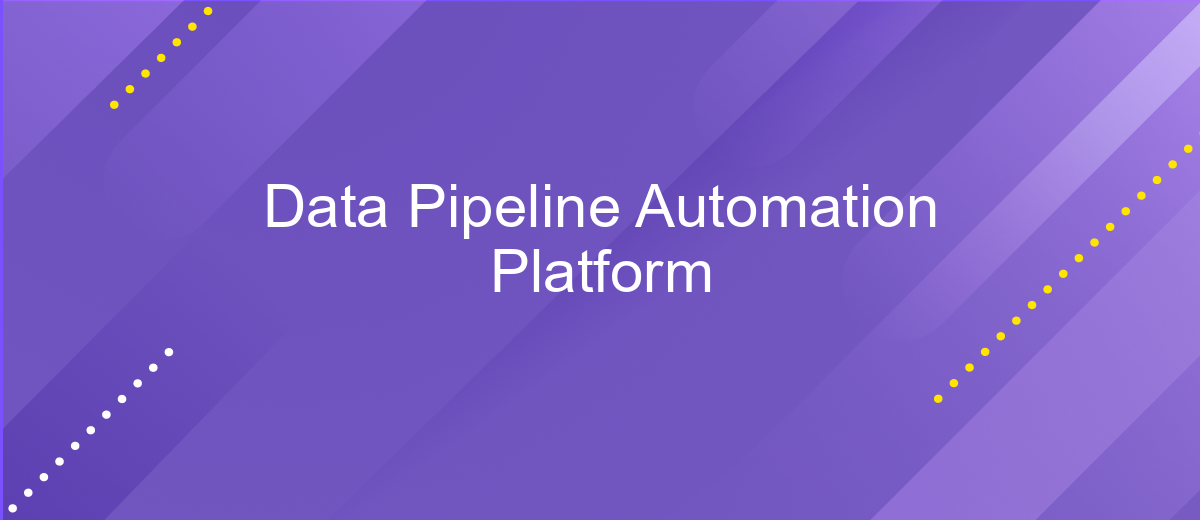Data Pipeline Automation Platform
In today's data-driven world, the ability to efficiently manage and process vast amounts of information is crucial. A Data Pipeline Automation Platform streamlines these tasks, enabling seamless data flow from source to destination. By automating data integration, transformation, and loading, this platform enhances productivity, reduces errors, and accelerates decision-making, empowering businesses to harness the full potential of their data.
Introduction
Data pipelines are essential components in modern data-driven organizations, enabling the efficient movement, transformation, and storage of data. However, managing these pipelines manually can be time-consuming and error-prone. This is where a Data Pipeline Automation Platform comes into play, offering a streamlined solution to automate the entire process.
- Reduces manual intervention and human errors
- Enhances data processing speed and efficiency
- Ensures data consistency and accuracy
- Facilitates scalability and flexibility
By leveraging a Data Pipeline Automation Platform, organizations can focus more on analyzing data and deriving actionable insights rather than getting bogged down by the complexities of data management. This not only improves operational efficiency but also drives better decision-making and business outcomes.
Benefits of Automating Your Data Pipeline

Automating your data pipeline provides numerous advantages that enhance the overall efficiency and reliability of your data processes. One of the key benefits is the significant reduction in manual intervention, which minimizes the risk of human error and ensures data consistency across various stages. Automation allows for real-time data processing, enabling businesses to make timely, data-driven decisions that can lead to improved operational performance and competitive edge.
Another crucial benefit is the seamless integration of various data sources and applications. Tools like ApiX-Drive facilitate easy and efficient integration, allowing you to connect diverse data systems without extensive coding knowledge. This not only saves time but also ensures that your data pipeline remains flexible and scalable as your business grows. Additionally, automated data pipelines can be easily monitored and maintained, providing transparency and control over the data flow, which is essential for compliance and governance.
Challenges of Data Pipeline Automation

Automating data pipelines presents several challenges that organizations must navigate to ensure seamless data flow and integrity. These challenges often stem from the complexities of data environments, the diversity of data sources, and the need for robust error handling mechanisms.
- Data Quality and Consistency: Ensuring that data remains accurate and consistent across various stages of the pipeline can be difficult, especially when dealing with heterogeneous data sources.
- Scalability: As data volumes grow, pipelines must be able to scale efficiently. This requires careful planning and often sophisticated infrastructure.
- Error Handling: Automated pipelines need robust mechanisms to detect, log, and recover from errors without human intervention.
- Security and Compliance: Protecting sensitive data and ensuring compliance with regulations like GDPR and HIPAA adds another layer of complexity.
- Integration: Seamlessly integrating various tools and technologies into a cohesive pipeline can be challenging, requiring custom solutions and ongoing maintenance.
Addressing these challenges requires a comprehensive strategy that includes thorough planning, the right choice of tools, and continuous monitoring. By proactively tackling these issues, organizations can build resilient and efficient data pipelines that support their analytics and business intelligence efforts.
Overcoming the Challenges of Data Pipeline Automation

Automating data pipelines presents several challenges that organizations must navigate to ensure seamless data flow and accurate analytics. One major hurdle is the integration of diverse data sources, each with its unique format and structure. This requires robust tools capable of handling various data types and ensuring compatibility across platforms.
Another significant challenge is maintaining data quality and integrity throughout the pipeline. Automated systems must be equipped with advanced validation and monitoring mechanisms to detect and rectify errors in real-time. Additionally, scalability is a concern as data volumes grow exponentially, necessitating scalable solutions that can expand without compromising performance.
- Integration of diverse data sources
- Maintaining data quality and integrity
- Scalability to handle growing data volumes
- Ensuring security and compliance
- Managing resource allocation efficiently
To overcome these challenges, organizations should invest in comprehensive data pipeline automation platforms that offer end-to-end solutions. These platforms should provide seamless integration capabilities, robust data validation tools, and scalable architecture. Additionally, incorporating security measures and compliance protocols will ensure that data remains protected and adheres to regulatory standards.


Conclusion
In summary, implementing a Data Pipeline Automation Platform significantly enhances the efficiency and reliability of data processing workflows. By automating data integration, transformation, and loading processes, organizations can ensure data accuracy and timeliness, which are critical for making informed business decisions. The platform's ability to handle large volumes of data from various sources streamlines operations and reduces the risk of human error.
Moreover, integrating services like ApiX-Drive can further simplify the automation process. ApiX-Drive offers seamless connectivity between different applications and systems, enabling smooth data flow without the need for extensive coding. This not only accelerates the integration process but also provides a scalable solution for growing data needs. Ultimately, a robust Data Pipeline Automation Platform, augmented with tools like ApiX-Drive, empowers businesses to harness the full potential of their data, driving innovation and competitive advantage.
FAQ
What is a Data Pipeline Automation Platform?
How does a Data Pipeline Automation Platform benefit my business?
Can I integrate multiple data sources with a Data Pipeline Automation Platform?
What types of data transformations can be performed in a Data Pipeline Automation Platform?
How do I get started with setting up a Data Pipeline Automation Platform?
Routine tasks take a lot of time from employees? Do they burn out, do not have enough working day for the main duties and important things? Do you understand that the only way out of this situation in modern realities is automation? Try Apix-Drive for free and make sure that the online connector in 5 minutes of setting up integration will remove a significant part of the routine from your life and free up time for you and your employees.

